Early hominids moved from dense forests to open savannahs, where standing upright helped them spot predators and travel long distances efficiently. Bipedalism also freed their hands for carrying food and tools, giving them a survival advantage. Thus, environmental changes and evolutionary pressures together favored the development of upright walking.
NCERT Class 12 Biology Chapter 7 Notes Evolution - Download PDF
Did you know humans and chimpanzees share about 98% of their DNA? The NCERT Class 12 Biology Chapter 6 Notes Evolution explain all the topics in a clear and well-understandable manner. These notes are designed for easy revision and quick learning. The Evolution chapter covers important topics such as the origin of life, theories of evolution, natural selection, adaptive radiation, and evidence supporting evolution. With well-labeled diagrams and short summaries, these NCERT Notes make studying concepts much simpler.
This Story also Contains
- NCERT Class 12 Biology Chapter 6 Evolution Notes: Download PDF
- Class 12 Biology Chapter 6 Evolution Notes
- Chapter 6 Evolution: Previous Year Question and Answers
- How to Use NCERT Class 12 Biology Chapter 6 Notes Effectively?
- Advantages of Class 12 Biology Chapter 6 Evolution Notes
- Chapter-Wise NCERT Class 12 Notes Biology

NCERT Class 12 Biology Chapter 6 Notes highlights the gradual development of species from simple to more complex forms, driven by mechanisms such as genetic variation, natural selection, genetic drift, and other factors. The Evolution chapter explains fossil evidence, homologous and analogous structures, and evolutionary adaptations in different organisms. These NCERT Notes for Class 12 are a perfect resource to revise all the topics effectively when time is limited during the board exams or competitive exams like NEET.
Note: This chapter is renumbered as Chapter 6 in the NCERT Class 12 Biology textbook as per the latest syllabus.
NCERT Class 12 Biology Chapter 6 Evolution Notes: Download PDF
Students can get easy access to all the important concepts and explanations in a single document. The NCERT Class 12 Biology Chapter 6 Evolution PDF is prepared for offline study, helping students revise efficiently and refer to it anytime without internet access. It organizes the content in a simple and understandable manner, making learning faster. These NCERT Notes for Class 12 Biology include well-labeled diagrams and clear summaries, which make the complex topics easier to understand.
Also check:
Class 12 Biology Chapter 6 Evolution Notes
Life on Earth has changed over millions of years, giving rise to the vast variety of organisms we see today. Studying these changes helps us understand how species adapt and survive in different environments. The Evolution Class 12 Notes provide clear explanations of the origin of life, evolutionary theories, natural selection, adaptive radiation, and the mechanisms that drive change over time. These notes are prepared carefully to help students revise effectively using the NCERT.
A Brief Account of Evolution
About 2000 million years ago, the first cellular form of life appeared on Earth.
Slowly, single-celled organisms became multicelled forms, and by the time 500 mya, invertebrates were formed and active.
Jawless fish evolved around 350 mya.
Organisms started to invade, from water to land. Fish with stout and strong fins could move on land and go back to water. These animals, called lobefins, evolved into the first amphibians.
Later, these amphibians evolved into reptiles. They lay shelled eggs. Then reptiles of different shapes and sizes dominated on earth: fish-like reptiles, e.g., Ichthyosaurs, and land reptiles, e.g., dinosaurs. The biggest of them was Tyrannosaurus rex.
Some of the reptiles evolved into birds, and later some of them became mammals. Mammals were viviparous and more intelligent at sensing and avoiding danger.
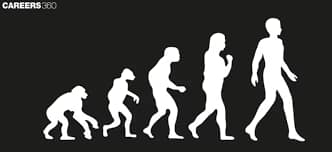
Darwin’s Theory of Evolution
Charles Darwin's Theory of Evolution, outlined in his seminal work "On the Origin of Species" (1859), introduced the concept of natural selection as the driving force behind the evolutionary process. Here are the main features of Darwin's Theory of Evolution:
Descent with Modification:
- Species share common ancestry.
- Change and divergence occur over time.
Natural Selection:
- Variation within populations.
- Traits providing an advantage for reproduction are favored.
Struggle for Existence:
- Competition for limited resources.
- Leads to a "struggle for existence."
Variation:
- Genetic differences result in variation.
- Variations are heritable.
Adaptation:
- Natural selection favors traits that enhance fitness.
- Populations become adapted to environments.
Survival of the Fittest:
- Individuals with advantageous traits survive and reproduce.
- Leads to the accumulation of beneficial traits.
Common Descent:
- All life shares a common ancestry.
- Diversity results from evolutionary divergence.
Gradualism:
- Evolutionary changes occur gradually.
- Small, incremental changes lead to significant transformations.
Other Evolutionary Theories
Given below are the other theories of evolution proposed by different scientists.
Some scientists believe that life comes from other planets. Early Greek thinkers thought that the unit of life is called spores transferred from other planets.
According to other theories, life comes out of dead and decaying matter like straw and mud. This theory is called the theory of spontaneous origin.
Louis Pasteur experimentally proved that life arises only from pre-existing life. The spontaneous theory of the origin of life is dismissed after that. Oparin and Haldane proposed that the first form of life could have come from pre-existing non-living organic molecules like RNA and protein, etc. The formation of life is preceded by chemical evolution. At that time, conditions on Earth were high temperatures, volcanic eruptions, and a reducing atmosphere containing CH4 and NH3.
Experimental Representation of Miller’s Urey Experiment
Miller's Urey experiment on the Origin of Life- S.L. Miller and Urey in 1953, experimented to show the origin of life on Earth in a physical environment similar to the conditions that prevailed at that time.
- Miller created similar conditions of temperature and pressure on a laboratory scale. He created electric discharge in a flask containing CH4, H2, NH3, and water vapor at 100°C.
- He observed the formation of amino acids in the flask after 15 days of electric discharge. A similar experiment by other scientists found the formation of sugars, nitrogen bases, pigments, and fats.
- Analysis of meteorite content also reveals similar compounds, which reveal that similar processes are occurring elsewhere in space. This experimental evidence about the origin of life is called the chemical evolution of life.
- The first non-cellular forms of life could have originated 3 billion years ago. They could have been giant molecules like RNA, Protein, and polysaccharides, etc.
- The cellular form of life was probably a single cell and originated in a water medium. The theory that the first form of life arose slowly through evolutionary forces from non-living molecules is called biogenesis.
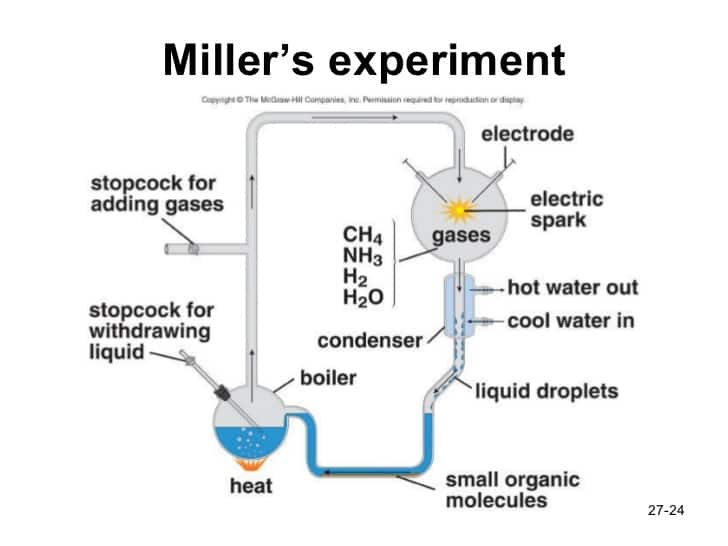
Evidence for Evolution
Evidence of Evolution: Evidence that evolution of life forms has taken place on Earth has many proofs, as mentioned below-
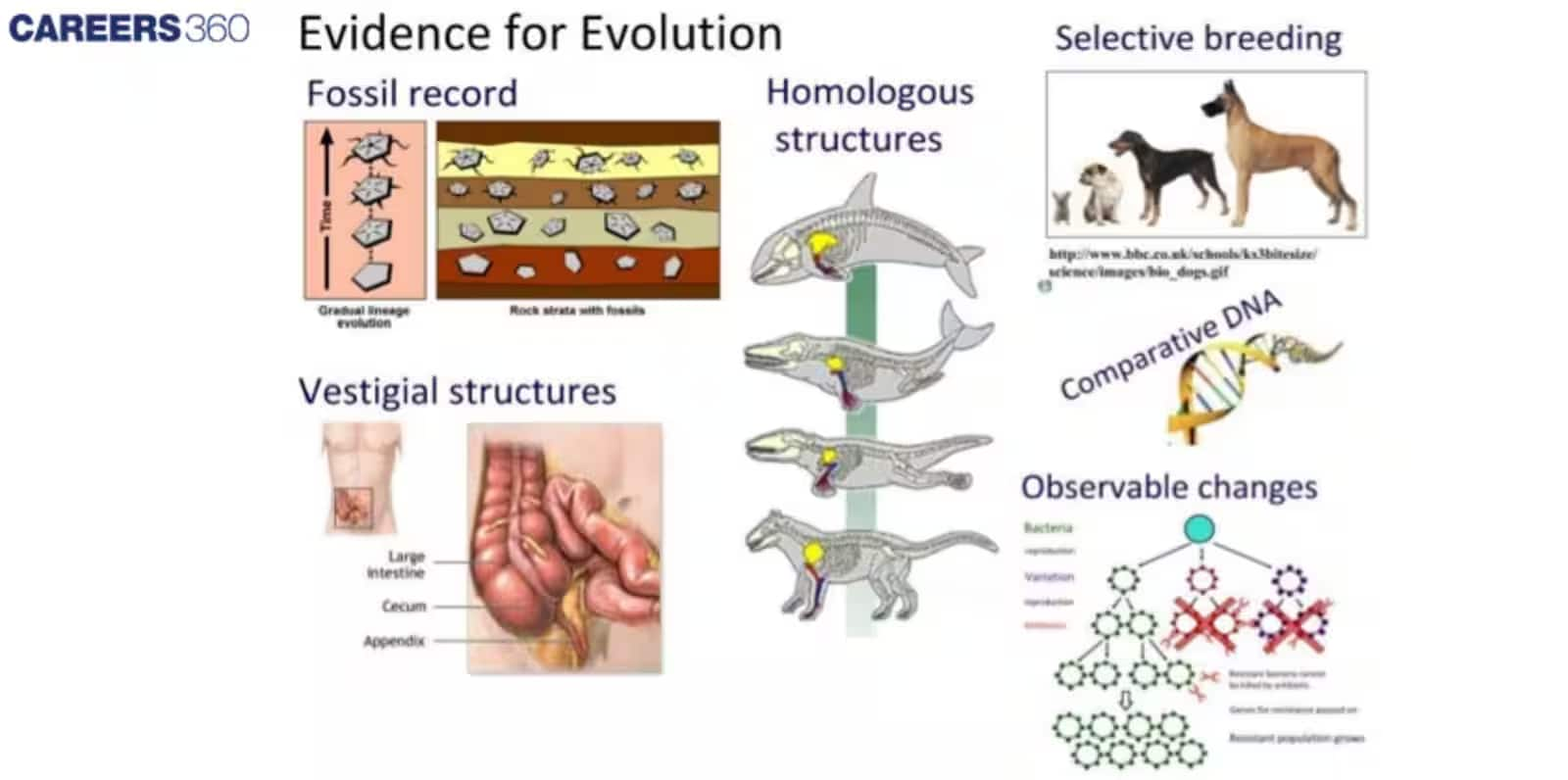
Paleontological evidence
Different-aged rock sediments contain fossils of different life forms that probably died during the formation of the particular sediment. Fossils are remains of hard parts of life-forms found in rocks. And the study showed that different forms varied over time, and certain life forms are restricted to a geological time span. Hence, new forms of life have arisen at different times in the history of the Earth.
Homologous organs
Those organs that perform different functions but have similar origins and structures are called homologous organs. For example, humans, cheetahs, bats, and whales share similarities in the pattern of bones of forelimbs, although these forelimbs perform different functions in these animals. In these animals, similar structures developed along with different directions due to the adaptation to different needs. This is called divergent evolution.
Analogous organs
They are not anatomically similar organs, but they perform similar functions. For example, the eyes of mammals and octopuses or the flippers of penguins and dolphins. This is due to similar habitats that resulted in similar adaptive features in different groups of organisms. This type of evolution is called convergent evolution.
Given below is the difference between homologous and analogous structures:
Homologous structures | Analogous structures |
Similar in anatomy | Dissimilar in anatomy |
Doing dissimilar functions | Doing similar functions |
Develop in related animals | Develop in unrelated animals |
Inherited from a common ancestor | Not inherited from a common ancestor |
Similar developmental pattern | The developmental pattern is not similar |
Similar structure and Origin | Dissimilar in structure and origin |
Biochemical pieces of evidence
Similarities in proteins and genes performing a given function among diverse organisms give hints of common ancestry. These biochemical similarities point to the same shared ancestry as structural similarities among diverse organisms.
DIVERGENT EVOLUTION | CONVERGENT EVOLUTION |
1. Development of different functional structures from a common ancestral form is called divergent evolution. | 1. The development of similar adaptive functional structures in unrelated groups of organisms is called convergent evolution. |
2. Homologous organs show divergent evolution. | 2. Analogous organs show convergent evolution. |
3. Examples: Darwin’s Finches, Australian Marsupials, locomotion in mammals. | 3. Examples: Australian Marsupials and Placental mammals, various aquatic vertebrates, and wings of insects, birds, and bats. |
Evolution by natural selection- Industrial melanism
A case of natural selection was seen in England in the 1850s, i.e., before industrialization, in a peppered moth (Biston betularia). This moth had two forms: grey and black (Carbonaria). In the early part of the nineteenth century, before industrialization, only the grey-colored forms of moths were present; the dark forms were rare. The grey-colored moths were seen on the tree trunks covered with lichens, and so they were able to escape from their enemies.
Later in 1920, due to the development of industries, post-industrialization, the lichens were killed and the tree trunks looked dark due to the deposition of industrial soot. Birds, now we’re able to spot these moths and feed upon them. So the grey-colored moths were eaten by the birds, and the dark-colored moths escaped from the birds. Now the coal is replaced by the industries, and oil and electricity are used. This has reduced the soot production and ultimately led to less deposition of soot on the tree trunks. These tree trunks have, now, again become grey in color. Consequently, grey-colored moths have again increased in number. This example clearly brings out the action of natural selection.
Evolution by anthropogenic action: resistance of mosquitoes to pesticides.
When DDT was introduced to control mosquitoes, it was tremendously successful. Most of the mosquitoes were sensitive to DDT and were therefore killed. In that population of mosquitoes, a few mosquitoes became resistant to DDT and survived. They multiplied, and now almost the entire population of mosquitoes is resistant to DDT.
The same pattern has been observed in bacteria that are multidrug-resistant due to excessive use of drugs and medicines.
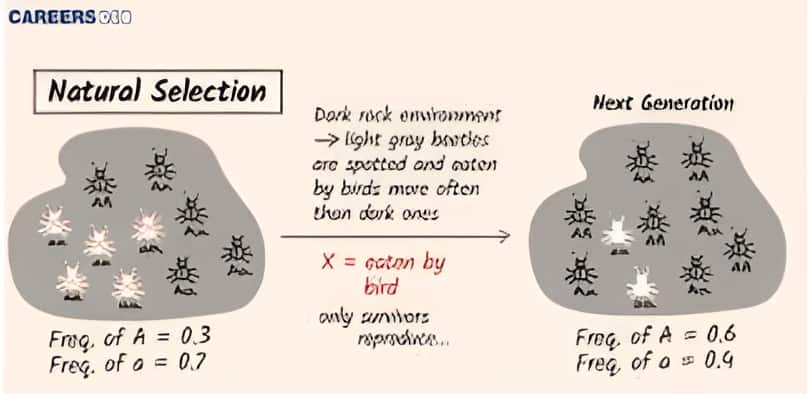
Adaptive Radiation
The process of evolution of different species in a given geographical area, starting from a point and radiating to other areas of geography (habitat), is called adaptive radiation. Darwin’s finches represent one of the best examples of adaptive radiation. Australian marsupials, each different from the other, evolved from one ancestral stock, but all within the Australian island continent.
When more than one adaptive radiation appears to have occurred in an isolated geographical area (representing different habitats), we can call this convergent evolution, e.g, Placental mammals and Australian marsupials.
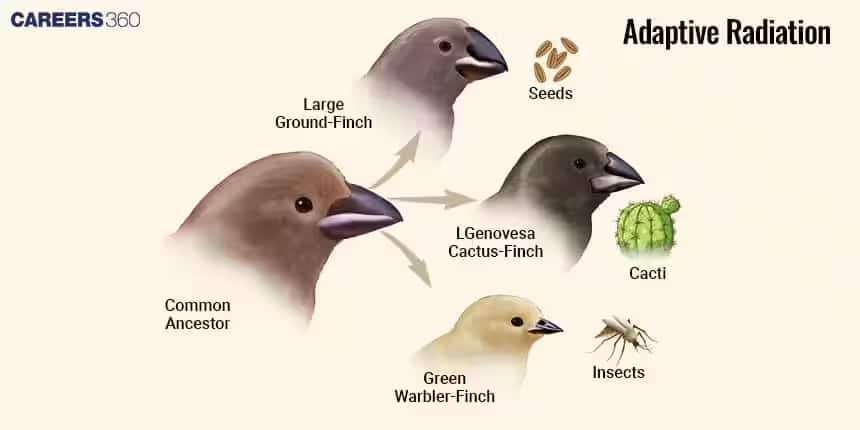
Biological Evolution
Biological Evolution is the natural selection for the fittest, and fitness is based on characteristics that are inherited. Some organisms are better adapted to survive in otherwise hostile environments. Fitness is the end result of the ability to adapt and be selected by nature.
Lamarck had said that the evolution of life forms had occurred, but was driven by the use and disuse of organs. He gave the example of giraffes evolving their necks by foraging leaves on tall trees and having to adapt by elongating their necks.
Branching descent and natural selection are the two key concepts of the Darwinian Theory of Evolution. Darwin's theory of natural selection was based on certain observations, such as:
Limited natural resources.
Overpopulation
Competition for resources
Struggle for existence
Survival of the fittest.
Mechanism of Evolution
Hugo de Vries, based on his work on evening primrose, brought forth the idea of mutation. A mutation is a large difference arising suddenly in a population.
Mutations are random and directionless, while Darwinian variations are small and directional. Hugo de Vries believed that mutation causes speciation, hence the term saltation (single-step large mutation).
Difference Among Lamarckism, Darwinism, and Mutation Theory
Properties | Lamarckism | Darwinism | Mutation Theory |
Vital force | The Lamarckism theory believes that every organism has an internal vital force that tends to increase its size up to a certain limit. | Darwinism does not believe in the internal vital force. | No internal vital force is involved. |
Conscious Reaction | Animals with a well-developed nervous system react consciously to any change in the environment | Darwinism does not involve any conscious reaction. | No conscious reaction is believed to take part in the process of evolution. |
Appetency | The theory considers appetency or desires on the part of animals as an important force in the development of modifications. | It is not a constituent of the theory. | Appetency is not involved. |
Use and Disuse | Organs put to more use are believed to develop more, while organs not used begin to degenerate. | The theory is silent about the use and disuse of organs. | The theory is silent about it. |
Inheritance of Acquired Characters | The characters acquired by an organism during its life are believed to be transferred to the next generation. | According to Darwin, all the living cells produce minute particles or pangenesis, which pass into germ cells for transmission to the offspring. | Only those variations are transferred to the offspring that originate in germ cells or in the cells that form germ cells. |
Struggle for Existence | The theory does not clearly spell out the struggle for existence in relation to high biotic potential. | Organisms produce more offspring than the available food and space, so a struggle for existence ensues amongst them. | The theory of evolution believes in the struggle for existence. |
Origin of Variations | Variations appear in organisms in response to changes in the environment, conscious reactions, and the desire to use and disuse organs. | variations appear automatically. | Variations appear due to changes in genetic makeup. |
Continuous Variations | The theory is silent about them, though it believes in a continuous modification of organs in a particular direction. | It is based on the origin and selection of continuous variations. | The theory is based on discontinuous variations or mutations. |
Natural Selection | The theory does not take into account natural selection or the survival of the fittest. | Darwinism is based on natural selection, or the survival of the fittest. | The Mutation theory believes in natural selection or survival of the fittest. |
Progress of Evolution | Evolution is a continuous process that moves in a direction governed by the environment and appetency. | Evolution is a continuous process, the direction of which is governed by nature. | Evolution is a jerky process, the direction of which is unpredictable, though ultimately it is governed by nature. |
Hardy-Weinberg Principle
In a given population, the frequency of occurrence of alleles or genes can be determined. These frequencies remain fixed and even remain the same through generations. This fact was represented by the Hardy-Weinberg principle using algebraic equations.
This principle states that allele frequencies in a population are stable and constant from generation to generation. The gene pool remains constant. This is called genetic equilibrium, and the sum total of all the allelic frequencies is 1.
When the frequency is measured, the actual value varies, which indicates the extent of evolutionary changes. Change of frequency in alleles (Hardy-Weinberg equilibrium) in a population resulted from evolution.
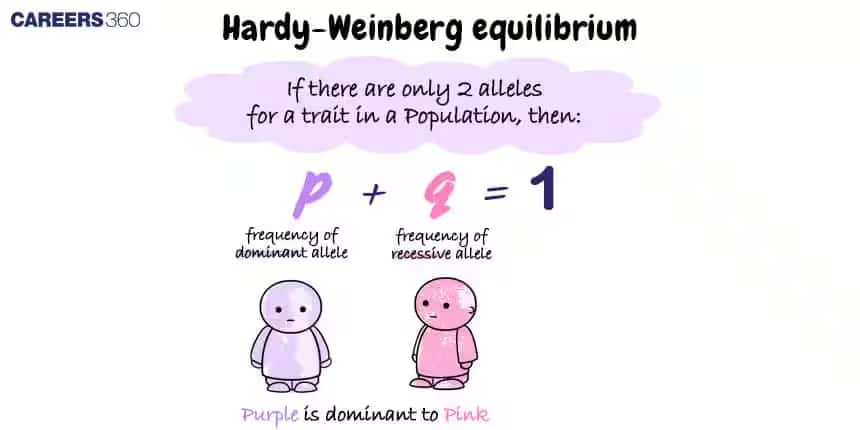
The factors that affect the Hardy-Weinberg equilibrium are:
• Gene migration or gene flow.
• Mutation
• Genetic recombination
• Natural selection.
During genetic drift, sometimes changes in allele frequency are so different in a sample of the population that they become different species. The original drifted population becomes the founder, and that effect is called the founder effect.
Also, Read
Chapter 6 Evolution: Previous Year Question and Answers
Previous years’ questions from this chapter are listed below. Students can understand important concepts of inheritance, variation, and related genetic principles by studying the Principles of Inheritance and Variation Class 12 Notes.
Question 1. The flippers of the Penguins and the Dolphins are an example of the
Option 1. Adaptive radiation
Option 2. Natural selection
Option 3. Convergent evolution
Option 4. Divergent evolution
Answer :
The flippers of penguins (birds) and dolphins (mammals) serve the same function of swimming, but evolved independently in unrelated groups. They show similarity in structure due to adaptation to a similar environment, not because of common ancestry. This is an example of convergent evolution.
Hence, the correct answer is option (3), Convergent Evolution
Question 2. What environmental factors and evolutionary pressures played a role in the emergence of bipedalism among our hominid ancestors?
Option 1. The proliferation of large carnivores that targeted small mammals led to the development of bipedalism.
Option 2. The transition from mountainous forests to flat grasslands prompted the evolution of bipedalism.
Option 3. The shift from forested habitats to open savannah environments influenced the emergence of bipedalism.
Option 4. The mass extinction of dinosaurs, followed by the subsequent rise of mammals, contributed to the development of bipedalism.
Answer :
Hence, the correct answer is option (3). The shift from forested habitats to open savannah environments influenced the emergence of bipedalism.
Question 3. In the case of the moth species Biston betularia, which form of natural selection can be attributed to the phenomenon of industrial melanism
Option 1. Stabilizing selection
Option 2. Directional selection
Option 3. Disruptive selection
Option 4. Artificial selection
Answer :
Industrial melanism is a phenomenon observed in moth populations, like Biston betularia, where dark-colored individuals become more common due to pollution. In polluted areas, lighter-colored moths are easily spotted and eaten by predators, while darker-colored moths are better camouflaged and have a higher chance of survival. This shift towards darker coloration is an example of directional selection, where the selective pressure favors one extreme of a trait, in this case, darker coloration, leading to an increase in its prevalence in the population.
Hence, the correct answer is option (2). Directional Selection
Question 4. The theory of natural selection was proposed by
Option 1. Gregor Mendel
Option 2. Charles Darwin
Option 3. Hugo de Vries
Option 4. Lamarck
Answer :
Charles Darwin proposed the theory of natural selection, explaining how organisms evolve over time through variation and survival of the fittest. His ideas were presented in the book On the Origin of Species. Mendel worked on inheritance, Lamarck proposed the theory of acquired characters, and Hugo de Vries suggested mutation theory.
Hence, the correct answer is option (2), Charles Darwin
Question 5. Homologous organs provide evidence for
Option 1. Convergent evolution
Option 2. Analogous evolution
Option 3. Common ancestry
Option 4. Adaptive radiation only
Answer :
Homologous organs have a similar basic structure but may perform different functions in different organisms. This similarity indicates that the organisms evolved from a common ancestor, providing strong evidence for divergent evolution.
Hence, the correct answer is option (3), Common ancestry
Also Read:
How to Use NCERT Class 12 Biology Chapter 6 Notes Effectively?
Life on Earth has not always been the same; life has changed and adapted over millions of years. Studying these changes helps us understand the origin of species and the diversity we see today.
Learn about early theories of evolution and how scientific ideas developed over time through Class 12 Biology Chapter 6 Evolution Notes.
Understand natural selection and how it explains survival and adaptation.
Explore the role of fossils and other evidence of evolution that support the idea.
Study the concept of adaptive radiation and how species diversify in different environments.
Revise Class 12 Biology Chapter 6 Evolution Notes to see how modern humans emerged step by step.
Advantages of Class 12 Biology Chapter 6 Evolution Notes
Evolution explains how life on Earth has changed over millions of years through processes like natural selection, mutation, and genetic drift. Studying this chapter helps students understand the origin of species and the diversity of organisms.
Class 12 Biology Chapter 6 Evolution Notes PDF helps in understanding the origin and diversification of life on Earth.
The notes also explain important concepts like natural selection, adaptation, and speciation in a clear and detailed manner.
It also helps in answering assertion, reason, and application-based questions, which are frequently asked in the exams.
Class 12 Biology Chapter 6 Evolution Notes PDF allows students to build a strong base for competitive exams like NEET.
The notes make it easier to relate theoretical concepts with real-life examples, such as industrial melanism and homologous organs.
Chapter-Wise NCERT Class 12 Notes Biology
Here is a table that presents notes for each chapter included in the Class 12 Biology. The notes cover all topics in an easy-to-understand manner and help students revise quickly and more effectively.
| NCERT Class 12 Biology Chapter 1 Sexual Reproduction in Flowering Plants Notes |
| NCERT Class 12 Biology Chapter 2 Human Reproduction Notes |
| NCERT Class 12 Biology Chapter 3 Reproductive Health Notes |
| NCERT Class 12 Biology Chapter 4 Principles of Inheritance and Variation Notes |
| NCERT Class 12 Biology Chapter 5 Molecular Basis of Inheritance Notes |
| NCERT Class 12 Biology Chapter 6 Evolution Notes |
| NCERT Class 12 Biology Chapter 7 Human Health and Disease Notes |
| NCERT Class 12 Biology Chapter 8 Microbes in Human Welfare Notes |
| NCERT Class 12 Biology Chapter 9 Biotechnology: Principles and Processes Notes |
| NCERT Class 12 Biology Chapter 10 Biotechnology and its Applications Notes |
| NCERT Class 12 Biology Chapter 11 Organisms and Populations Notes |
| NCERT Class 12 Biology Chapter 12 Ecosystem Notes |
| NCERT Class 12 Biology Chapter 13 Biodiversity and Conservation Notes |
Frequently Asked Questions (FAQs)
Studying evolution helps us understand how species have changed over millions of years and adapted to their environments. It explains the diversity of life, the relationship between different organisms, and the mechanisms that drive changes in populations over time.
The Evolution chapter is highly important as it forms the basis for understanding heredity, adaptation, and biodiversity. Questions from this chapter are frequently asked in board exams and competitive exams like NEET, making it essential to revise thoroughly and understand key concepts.
The important concepts of NCERT Class 12 Biology Chapter 6 Notes Evolution are “The Big Bang Theory”, Condition of Early Earth, Origin of Life, Urey and Miller Experiment, Paleontological Evidence, Divergent Evolution, Convergent Evolution, Evolution by Natural Selection, Darwin’s Rule, Biological Evolution, Lamarck Theory of Evolution, Hardy Weinberg Principle, and Origin and Evolution of Man.
An allele is one of the alternative forms of a gene that occupies a specific position on a chromosome. Genes, which are segments of DNA, code for specific traits or characteristics. Alleles represent different versions or variations of a gene, and they can result in different observable features, such as eye color or blood type.
Genetic drift is the random fluctuation of allele frequencies in a population over generations due to chance events in reproduction, survival, and migration. It is particularly influential in small populations, leading to changes in the gene pool that are unrelated to the organisms' fitness or natural selection. The two main forms are the bottleneck effect and the founder effect.
Popular Questions
Courses After 12th
Applications for Admissions are open.
As per latest syllabus. Physics formulas, equations, & laws of class 11 & 12th chapters
JEE Main Important Chemistry formulas
Get nowAs per latest syllabus. Chemistry formulas, equations, & laws of class 11 & 12th chapters
JEE Main high scoring chapters and topics
Get nowAs per latest 2024 syllabus. Study 40% syllabus and score upto 100% marks in JEE
JEE Main Important Mathematics Formulas
Get nowAs per latest syllabus. Maths formulas, equations, & theorems of class 11 & 12th chapters

